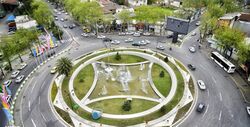Place:Gorgan
Gorgan Persian: گرگان Esterabad | |
|---|---|
City | |
Gorgan Tower, Gorgan Mosque, Gorgan Palace, Roundabout | |
| Coordinates: [ ⚑ ] : 36°50′16″N 54°26′29″E / 36.83778°N 54.44139°E[1] | |
| Country | |
| Province | Golestan |
| County | Gorgan |
| District | Central |
| Government | |
| • Mayor | Mohammad Reza Seyed Alangi[2] |
| • City Council Chairperson | Isa Mehri[3] |
| Area | |
| • Total | 1,700 km2 (656 sq mi) |
| Elevation | 155 m (509 ft) |
| Population (2016)[4] | |
| • Total | 350,676 |
| • Density | 210/km2 (530/sq mi) |
| Time zone | UTC+03:30 (IRST) |
| Climate | Csa |
| Template:GEOnet2 | |
Gorgan (Persian: گرگان [ɡoɾˈɡɒːn] (![]() listen); also romanized as Gorgān, Gurgān, and Gurgan), formerly Esterabad (استرآباد [ʔæsˌtæɾɒːˈbɒːd]; also romanized as Astarābād, Asterabad, and Esterābād),[5] is a city in the Central District of Gorgan County, Golestan province, Iran, serving as the capital of the district, the county, and the province. It lies approximately 400 km (250 mi) to the northeast of the national capital Tehran, and some 30 km (19 mi) away from the Caspian Sea.
listen); also romanized as Gorgān, Gurgān, and Gurgan), formerly Esterabad (استرآباد [ʔæsˌtæɾɒːˈbɒːd]; also romanized as Astarābād, Asterabad, and Esterābād),[5] is a city in the Central District of Gorgan County, Golestan province, Iran, serving as the capital of the district, the county, and the province. It lies approximately 400 km (250 mi) to the northeast of the national capital Tehran, and some 30 km (19 mi) away from the Caspian Sea.
At the 2006 National Census, its population was 269,226 in 73,702 households.[6] The following census in 2011 counted 329,536 people in 98,019 households.[7] The latest census in 2016 showed a population of 350,676 people in 111,099 households.[4]
History
There are several archaeological sites near Gorgan, including Tureng Tepe and Shah Tepe, in which remains dating from the Neolithic and Chalcolithic eras. Some other important Neolithic sites in the area are Yarim Tepe, and Sange Chaxmaq. The nearby Shahroud Plain has many such sites. More than 50 are on the Gorgan Plain.[8]
According to the Greek historian Arrian, Zadracarta was the largest city of Hyrcania and the site of the "royal palace".[9] The term means "the yellow city", and it was given to it from the great number of oranges, lemons, and other fruit trees which grew in the outskirts of that city.[10]
Hyrcania became part of the Achaemenid Empire during the reign of Cyrus the Great (559–530 BC), its founder, or his successor Cambyses (530-522 BC).
The Great Wall of Gorgan, the second biggest defensive wall in the world, was built in the Parthian and Sassanian periods.
At the time of the Sassanids, "Gurgan" appeared as the name of a city, province capital, and province.[11]
Gorgan maintained its independence as a Zoroastrian state even after Persia was conquered by the Muslim Arabs in the 8th century.
In 1210, the city was invaded and sacked by the army of Kingdom of Georgia under command of the brothers Mkhargrdzeli.[12][13]
"Old Gorgan" was destroyed during the Mongol invasion in the 13th century, and the center of the region was moved to what was called "Astarabad", which is currently called "Gorgan".
Gorgan with its surrounding regions was sometimes considered part of the Tabaristan region.
Astarabad was an important political and religious city during the Qajar era.
Geography
The wide Dasht-e Gorgan (Plains of Gorgan) is located north of the city and geographically bounded by 37°00' - 37°30' north latitude and 54°00' - 54°30' east longitude, covering an area of about 170 square kilometres (66 sq mi).
Some 150 km (93 mi) east of Gorgan is the Golestan National Park, home to a large portion of the fauna of Iran.
The Gorgān Dam is situated 60 km northeast of Gorgan city and has a capacity of 100 million cubic meters.[14]
Climate
Gorgan has a subtropical mediterranean climate (Köppen: Csa, Trewartha: Cs), with hot, humid summers and cool, wet winters. In general, Golestan has a moderate and humid climate known as "the moderate Caspian climate". The effective factors behind such a climate are Alborz mountain range, the direction of the mountains, the height of the area, the neighborhood to the sea, vegetation surface, local winds, altitude, and weather fronts. As a result of the above factors, three different climates exist in the region: plain moderate, mountainous, and semi-arid. Gorgan valley has a semi-arid climate. The average annual temperature is 17.8 °C (64.0 °F) and the annual rainfall is roughly 584 millimetres (23.0 in).
Script error: No such module "weather box".
Notable people
Ancient
- Fakhroddin Asaad Gorgani, 11th-century Persian poet and the composer of Vis and Ramin.
- Abu Sa'id al-Darir al-Jurjani, 9th century astronomer and mathematician
- Al-Masihi, 10th century physician and teacher of Avicenna
- Abd al-Qāhir al-Jurjānī, 11th century grammarian and literary theorist
- Zayn al-Din al-Jurjani, 12th century royal physician
- Bahram al-Da'i, 12th-century Nizari Ismaili missionary and military leader in Syria
- Fazlallah Astarabadi (Naimi), 14th century mystic and founder of Hurufism
- Rustam Gorgani, 16th century physician
- Mir Fendereski, philosopher, poet and mysti
- Mir Damad, 17th century Islamic scholar and Neoplatonic philosopher
- Mirza Mehdi Khan Astarabadi, 18th century chief minister to Nader Shah
- Bibi Khatoon Astarabadi, writer, satirist and feminist
- Firishta, historian
- Sardar Rafie Yanehsari, Governor of Astarabad
Modern
- Iraj Etesam, Iranian architect, educator and author; born in Gorgan.[16]
- Nader Ebrahimi, author, poet, director and researcher
- Hossein Khanzadi, admiral in the Iranian Navy
- Mohammad Reza Lotfi, traditional Persian musician
- Maryam Zandi, photographer
- Parham Maghsoodloo, Chess grandmaster
Education
- Golestan University
- Golestan University of Medical Sciences[17]
- Gorgan University
- Islamic Azad University of Gorgan
- Lamei Gorgani institute of Higher Education
Sports
Shahrdari Gorgan competes in the Iranian Basketball Super League and Etka Gorgan F.C. competes in the Azadegan League.
Sister cities
See also
- Gorgan International Airport
- al-Jurjani
- Gorgan-rud River
- Gurganj
References
- ↑ OpenStreetMap contributors (13 October 2023). "Gorgan, Gorgan County" (Map). OpenStreetMap. Retrieved 13 October 2023.
- ↑ Golestane Javan [|permanent dead link|dead link}}]
- ↑ "«عیسی مهری» رئیس شورای شهر گرگان شد" (in fa). 17 June 2023. https://www.farsnews.ir/golestan/news/14020327000886/%D8%B9%DB%8C%D8%B3%DB%8C-%D9%85%D9%87%D8%B1%DB%8C-%D8%B1%D8%A6%DB%8C%D8%B3-%D8%B4%D9%88%D8%B1%D8%A7%DB%8C-%D8%B4%D9%87%D8%B1-%DA%AF%D8%B1%DA%AF%D8%A7%D9%86-%D8%B4%D8%AF.
- ↑ 4.0 4.1 "Census of the Islamic Republic of Iran, 1395 (2016)" (in fa) (Excel). The Statistical Center of Iran. p. 27. https://www.amar.org.ir/Portals/0/census/1395/results/abadi/CN95_HouseholdPopulationVillage_27.xlsx.
- ↑ Gorgan can be found at GEOnet Names Server, at this link, by opening the Advanced Search box, entering "-3064853" in the "Unique Feature Id" form, and clicking on "Search Database".
- ↑ "Census of the Islamic Republic of Iran, 1385 (2006)" (in fa) (Excel). The Statistical Center of Iran. p. 27. http://www.amar.org.ir/DesktopModules/FTPManager/upload/upload2360/newjkh/newjkh/27.xls.
- ↑ "Census of the Islamic Republic of Iran, 1390 (2011)" (in fa) (Excel). The Statistical Center of Iran. p. 27. https://irandataportal.syr.edu/wp-content/uploads/Golestan.xls.
- ↑ Kourosh Roustaei (2017), Neolithic developments in the Gorgan Plain, south-east of the Caspian Sea. academia.edu
- ↑ Arrian (1884). "Chapter XXV: March to Bactra.—Bessus Aided by Satibaezanes.". The Anabasis of Alexander. 3. Translated by E.J. Chinnock. London: Hodder and Stoughton. p. 191–193.
- ↑ electricpulp.com. "GORGAN v. Pre-Islamic history – Encyclopaedia Iranica". http://www.iranicaonline.org/articles/gorgan-v.
- ↑ Bivar, A.D.H. "Gorgan" Encyclopædia Iranica online
- ↑ Yar-Shater, Ehsan (2010). Encyclopaedia Iranica, Volume 2, Parts 5-8. Abingdon, United Kingdom: Routledge & Kegan Paul. p. 892. ISBN 9780710090904. https://books.google.com/books?id=1kQOAQAAMAAJ.
- ↑ Brosset, Marie-Felicite (1858). Histoire de la Géorgie depuis l'Antiquité jusqu'au XIXe siècle. France: imprimerie de l'Académie Impériale des sciences. pp. 468–472. https://archive.org/details/bub_gb_HfB0iPdpelgC.
- ↑ "GORGAN i. Geography". Encyclopedia Iranica. https://iranicaonline.org/articles/gorgan-i.
- ↑
- ↑ "بزرگداشت دکتر ایرج اعتصام، پیشکسوت آموزش معماری ایران". 2013-04-24. http://shasa.ir/newsdetail-74963-fa.html.
- ↑ "Golestan University of Medical Sciences- دانشگاه علوم پزشكي گلستان - Golestan University of Medical Sciences - دانشگاه علوم پزشكي گلستان". GOUMS. http://www.goums.ac.ir/.
- ↑ KZ-Today September 11, 2006
 |










